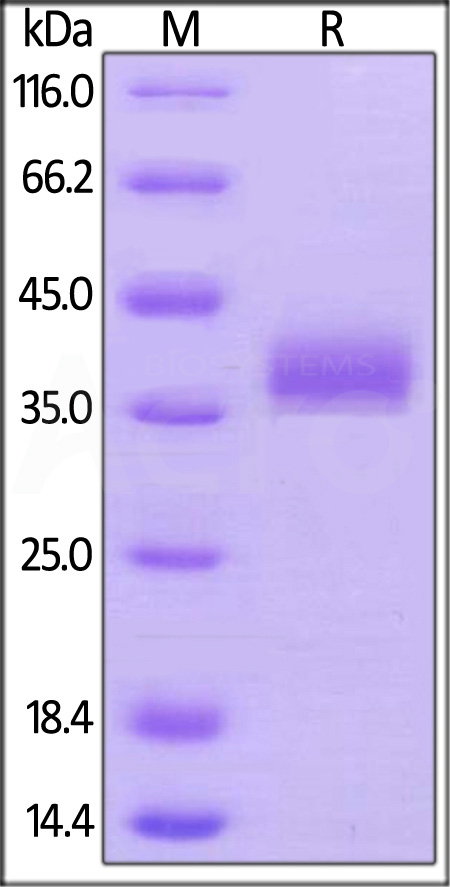分子别名(Synonym)
BTN1A1,Butyrophilin,BTN
表达区间及表达系统(Source)
Biotinylated Human BTN1A1, His,Avitag (BT1-H82E6) is expressed from human 293 cells (HEK293). It contains AA Ala 27 - Arg 242 (Accession # Q13410-1).
Predicted N-terminus: Ala 27
Request for sequence
蛋白结构(Molecular Characterization)

This protein carries a polyhistidine tag at the C-terminus, followed by an Avi tag (Avitag™).
The protein has a calculated MW of 27.6 kDa. The protein migrates as 36-40 kDa under reducing (R) condition (SDS-PAGE) due to glycosylation.
标记(Biotinylation)
Biotinylation of this product is performed using Avitag™ technology. Briefly, the single lysine residue in the Avitag is enzymatically labeled with biotin.
蛋白标记度(Biotin:Protein Ratio)
Passed as determined by the HABA assay / binding ELISA.
内毒素(Endotoxin)
Less than 1.0 EU per μg by the LAL method.
纯度(Purity)
>90% as determined by SDS-PAGE.
制剂(Formulation)
Lyophilized from 0.22 μm filtered solution in PBS, pH7.4. Normally trehalose is added as protectant before lyophilization.
Contact us for customized product form or formulation.
重构方法(Reconstitution)
Please see Certificate of Analysis for specific instructions.
For best performance, we strongly recommend you to follow the reconstitution protocol provided in the CoA.
存储(Storage)
For long term storage, the product should be stored at lyophilized state at -20°C or lower.
Please avoid repeated freeze-thaw cycles.
This product is stable after storage at:
- -20°C to -70°C for 12 months in lyophilized state;
- -70°C for 3 months under sterile conditions after reconstitution.
电泳(SDS-PAGE)

Biotinylated Human BTN1A1, His,Avitag on SDS-PAGE under reducing (R) condition. The gel was stained with Coomassie Blue. The purity of the protein is greater than 90%.
背景(Background)
Butyrophilin subfamily 1 member A1 (BTN1A1) is also known as BTN, which is a member of the immunoglobulin superfamily and the major protein associated with fat droplets in the milk. BTN1A1 may have a cell surface receptor function. The human butyrophilin gene is localized in the major histocompatibility complex (MHC) class I region of 6p and may have arisen relatively recently in evolution by the shuffling of exons between 2 ancestral gene families. Furthermore, BTN1A1 regulates the amount of lipids and size of droplets expressed in milk and inhibits the proliferation of CD4 and CD8 T-cells activated by anti-CD3 antibodies, T-cell metabolism and IL2 and IFNG secretion.























































 膜杰作
膜杰作 Star Staining
Star Staining












